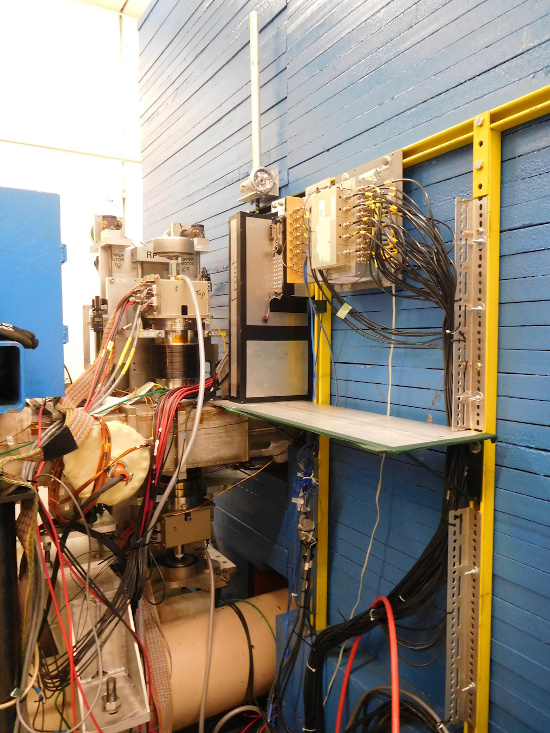Jun. 23, 2020 Press Release Physics / Astronomy
New research deepens mystery of particle generation in proton collisions
A group of researchers including scientists from the RIKEN Nishina Center for Accelerator-Based Science, University of Tokyo, Nagoya University, and the Japan Atomic Energy Agency (JAEA) used the spin-polarized Relativistic Heavy Ion Collider at Brookhaven National Laboratory in the United States to show that, in polarized proton-proton collisions, neutral pions emitted in the very forward area of collisions—where direct interactions involving quarks and gluons are not applicable—still have a large degree of left-right asymmetry. This finding suggests that the previous consensus regarding the generation of particle in such collisions need to be reevaluated.
Understanding the mechanism through which particles are created in collisions involving protons has relevance for understanding cosmic ray showers, where particles entering the earth’s atmosphere from outer space create particle “showers” that help us learn about astronomical phenomena that take place in the extreme environment of the universe. However, it is very difficult to study how particles are created, as the force that binds protons in the nucleus and that bind quarks and gluons into protons—the strong interaction or nuclear force—is very strong compared to other forces such as the electromagnetic force and gravity. One avenue for exploring these important challenges has involved an attribute of protons called “spin,” which can be understood by analogy to the way a toy top rotates on its axis. The spin of protons can be artificially aligned, in a process that is called "polarization".
In the 1970s, accelerator experiments at Argonne National Laboratory in the United States revealed that the pions generated toward the front of collisions involving polarized protons had large left-right asymmetry. The energy of the polarized protons used in these experiments was about 10 billion electron volts (GeV). Experiments at higher energies—including one at 200 GeV using the polarized proton beam at Fermi National Accelerator Laboratory (FNAL) in the United States and at RHIC at Brookhaven National Laboratory (BNL) in the United States, where two beams of 100 GeV protons moving in opposite directions were collided—showed that the left-right asymmetry persisted even with high-energy polarized protons. A consensus emerged that this asymmetry was caused by direct interactions among the quarks and gluons in the protons, based on a theory called perturbative quantum chromodynamics (QCD).
However, with additional experiments at the RHIC, findings began to emerge that challenged the consensus. According to Yuji Goto, one of the authors of the current work, “At the energy of RHIC, quarks and gluons are scattered, and various particles are generated in the form of a jet. When the left-right asymmetry of the jet generated forward of the collision position at RHIC was examined, it was found that, contrary to expectations, the overall jet and the pions contained in the jet did not show a left-right asymmetry. This suggested that the cause of the left-right asymmetry was not the direct scattering of quarks and gluons.”
n order to further investigate, the researchers conducted experiments, published in Physical Review Letters, where they used an electromagnetic calorimeter detector previously used in the Large Hadron Collider at CERN—known as the LHCf experiment there and the RHICf experiment at RHIC—to take a detailed look at the gamma rays generated by pion decays at the very forward region of the collision. They found, however, that the left-right asymmetry in neutral pions persists even in that very narrow area.
According to Goto, “We found that the asymmetry continues to exist at a very narrow angle from right in front of the collision, and in fact increases as the angle moves away from zero. This result necessitates a reexamination of previous theoretical interpretations. The small forward angle of the asymmetry corresponds to the energy region in which the protons cause the excited state, and the contribution of other mechanisms—diffraction and resonance—may provide a hint to the mystery.”
According to Minho Kim, an International Program Associate at RIKEN and graduate student at Korea University, who was the first author of the experiment, “It was great to be able to work with the new detector, and we plan to continue our work to understand the mechanism that generates the left-right asymmetry. This is sure to give us insights into cosmic ray showers and thus help us to understand phenomena that take place in the extreme environment of the universe.”
More information on the RHICf experiment is available at The RHICf experiment website.
Reference
- Kim et al. (2020). Transverse single-spin asymmetry for very forward neutral pion production in polarized p + p collisions at √s = 510 GeV, Phys Rev Lett. DOI: 10.1103/PhysRevLett.124.252501
Contact
Senior Research Scientist
Yuji Goto
Radiation Laboratory
RIKEN Nishina Center for Accelerator-Based Science
International Program Associate
Minho Kim
Radiation Laboratory
RIKEN Nishina Center for Accelerator-Based Science
Jens Wilkinson
RIKEN International Affairs Division
Tel: +81-(0)48-462-1225 / Fax: +81-(0)48-463-3687
Email: pr [at] riken.jp

Schematic of the experiment

A portion of the detector
